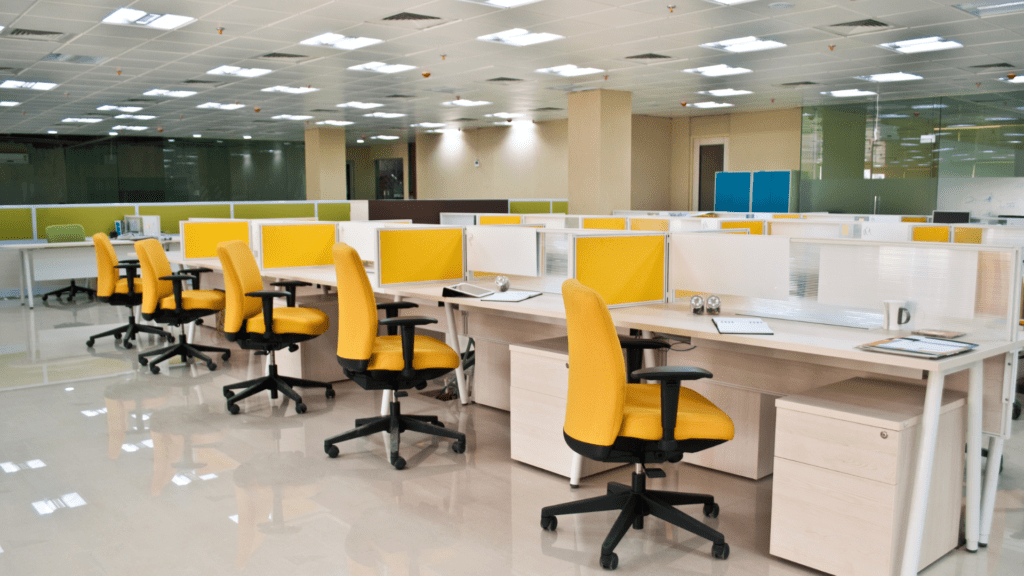Working in a shared office space can be both exciting and challenging. On the one hand, it allows us to collaborate with colleagues on projects and brainstorm ideas. On the other hand, it can also mean competing for resources like desk space or having to share equipment such as computers and phones.
With an increase in hybrid working conditions, companies are looking for ways to better utilize the space available and shared workstations are often looked to for this goal. But are they a good idea and how can companies continue to keep their employees healthy and productive?
This is why understanding the ergonomics of a shared workspace is essential for maximizing productivity while minimizing discomfort or injury. In this blog post, we will explore how you can create an ergonomic setup that works best when sharing a workstation between employees.
What is a Shared Workstation?
A shared workstation is a workspace that is used by multiple individuals for varying lengths of time. This can include a desk, chair, and other items like monitors or telephones. It’s important to understand how people use the space differently so that you can be sure to provide an ergonomic workspace for everyone who uses it.
With the hybrid work model this is an appealing concept to many employers. It allows them to decrease the amount of space they are using since everyone isn’t in the office at the same time.
However, shared workstations don’t work well for all employees and there are several drawbacks of implementing this type of workplace.

The Importance of Ergonomics in a Shared Workstation
Ergonomics is the study of how people interact with their environment. It’s a way to optimize workstation design so that it fits the physical needs of each individual user. This can include adjusting chair height and setting up proper monitor placement, as well as looking at other factors such as lighting, noise levels and air quality.
When designing an ergonomic shared workstation, it’s important to consider these factors for each individual user. By making sure that everyone has the correct setup for their particular needs, you can help ensure a comfortable and productive workspace. It will be crucial that each station offers the same features and benefits so that employees are familiar with the setup and able to adjust the desk accordingly.
Chair Variety and Availability to each Employee
Having multiple types of adjustable chairs available for employees to use is essential in a shared workstation. Different people have different needs when it comes to their seating, and having a variety of sizes, shapes and styles can help ensure everyone has the right fit.
A great option for ensuring each employee has the chair and support they need is to let the employee move their assigned chair from one workstation to the next.
Chairs are a very personal setup and often require frequent fine-tuning over the course of days or weeks until the fit is comfortable and accurate for the person. Therefore, providing chairs that move with the employee to different workstations can be a huge benefit in preventing ergonomic related musculoskeletal injuries.

Monitor Adjustment for Different Heights and Sizes
Having adjustable monitors is essential in a shared workstation. Different users have different needs when it comes to monitor placement – some may need a taller monitor, while others may need a shorter one. The correct placement of all monitors is having the top of the screen at eye level, ensuring proper head alignment during the workday.
Having easily adjustable monitors ensures that each user can properly adjust their monitor for their individual needs.
Adjustable Desks
Adjustable desks are another important component of a shared workstation. Having adjustable heights allows each user to customize the desk to their own needs and preferences, ensuring that everyone can find the right fit. This also helps avoid any strain caused by having to reach too high or too low for items on the desk.
Additionally, making sure each employee knows how to correctly adjust their desk height is critical. An adjustable desk helps no one if they aren’t adjusted correctly to the person.
Drawbacks of Shared Workstations
Shared workstations can be a great way to save space and increase flexibility for employers. However, it’s important to consider the drawbacks of having a shared workspace before implementing one.
The most obvious is privacy, since each employee will be sharing their workspace with other members in the office. This can lead to distractions and a lack of focus for some employees.
Organization is also a challenge with shared workstations. It can be difficult to keep a neat workspace when you have multiple people using the same area and needing to bring all their supplies with them each day.
Additionally, due to the frequent switching of users, it can be difficult to ensure that each user has access to all necessary materials and supplies.
A study in 2012 found a strong association between work-related musculoskeletal disorders and poor ergonomic workstations. It can be concluded from this study that with a shared workstation there is an increased risk of musculoskeletal disorders in employees due to the lack of proper ergonomics at the workstation.
Many employees will not take the time nor have the knowledge to appropriately adjust a workstation to prevent injury.

Conclusion
Shared workstations are a great way to save money and help create a collaborative environment in the workplace. However, creating an ergonomic setup is key to helping employees stay comfortable and productive, this can prove to be quite challenging as well. It is important for employers to consider the drawbacks that come with shared workstations, as well as take steps to address any potential ergonomic related issues.
By equipping each station with adjustable chairs, monitors and desks and providing employees with education on how to properly adjust their own station, employers can help ensure an ergonomically sound environment for their employees.
This will help maintain a productive and healthy working environment, while preventing any potential ergonomic related injuries.
Contact WorkSafe to find out how we can help your company today!
Working to keep you safe, healthy, and productive,

